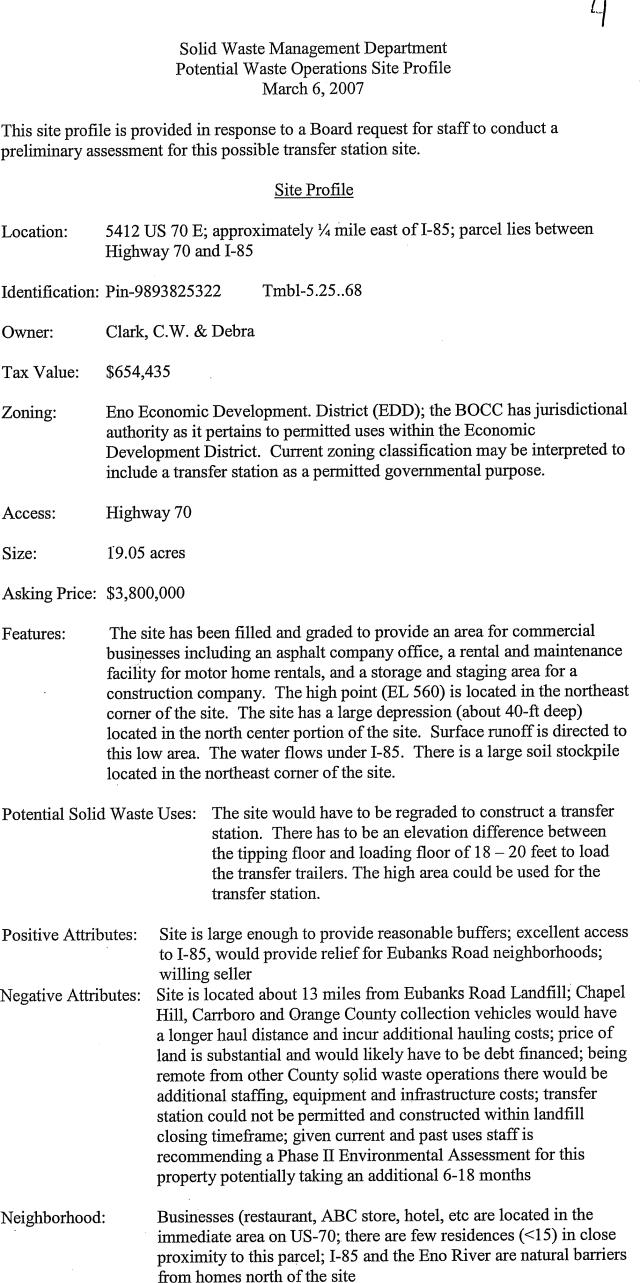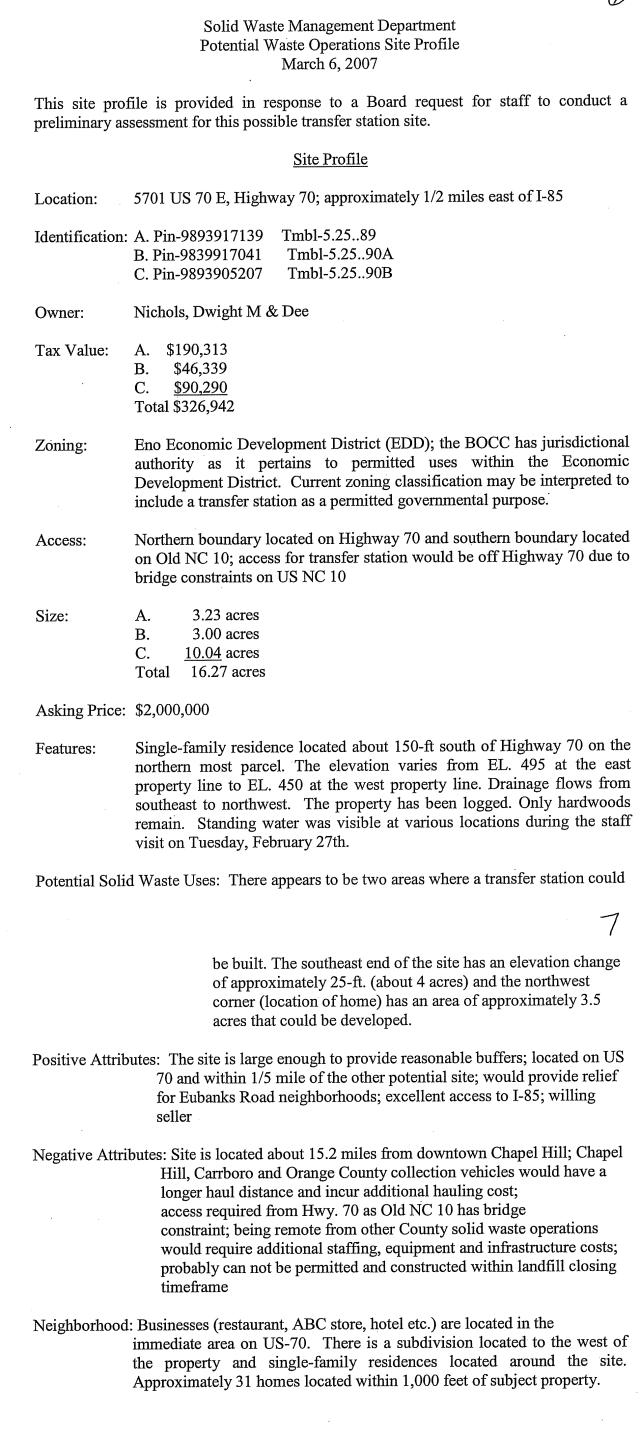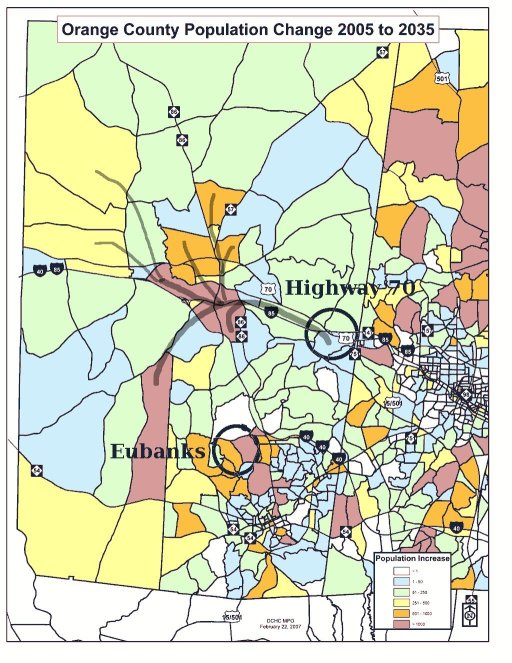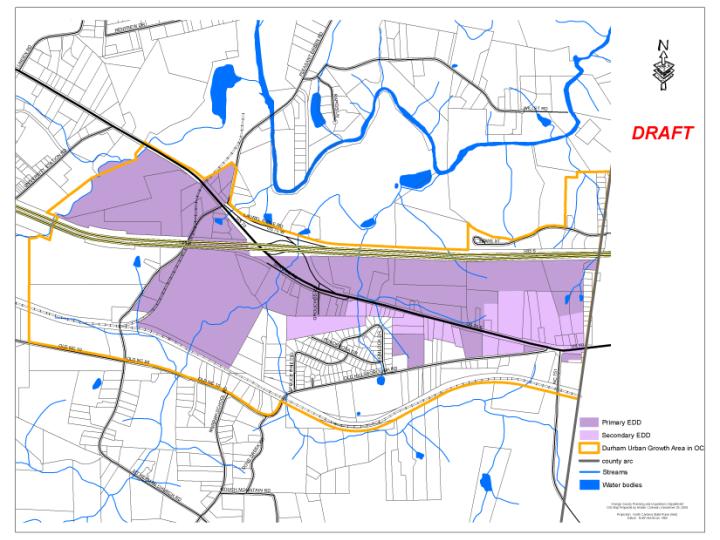To try to get the conversation caught up to date (and put the notes in a format Google, Yahoo, etc. will index), I’m republishing the further conversations the Orange County Solid Waste Advisory Board (SWAB) has had on land fill gas utilization.
Current membership (as of January 2007) and contact list for the SWAB includes:
| Contact List | |||||
| Members | |||||
| Name | Representing | Work # | Home # | FAX # | |
| Jan Sassaman (Chair) | Chapel Hill (A) | janopus@nc.rr.com | 933-1609 | ||
| Randolph Kabrick | Chapel Hill (B) | rkabrick@retec.com | 484-2200 | 942-4062 | 484-8100 |
| Albert F. Vickers | Carrboro (B) | alvickers@cleansites.com | 656-5271 | 929-0502 | 929-0011 |
| Linda Bowerman | Carrboro (A) |
lbowerman@mindspring.com |
967-8571 | ||
| Vacant | Hillsborough (A) | Contact Donna Armbrister donna.armbrister@hillsboroughnc.org | 732-1270 ext. 71 | ||
| Remus Smith | Hillsborough (B) | 732-3807 | 732-3807 | ||
| Bonnie Norwood | Orange County (A) | 967-4401 | |||
| Joe Clayton | Orange County (B) | jclayton@nc.rr.com | 644-6981 | ||
| Commissioner Liaisons | |||||
| Mike Nelson | Board of County Commissioners | mnelson@co.orange.nc.us | |||
| Barry Jacobs | Board of County Commissioners | barry.j@mindspring.com | 732-4941 | 732-4384 | 732-4486 |
| UNC Liaison | |||||
| B J Tipton | UNC-CH | btipton@fac.unc.edu | 962-7251 |
|
962-8794 |
| Staff | |||||
| Rod Visser | rvisser@co.orange.nc.us | 245-2308 | 644-3004 | ||
| John Link | jlink@co.orange.nc.us | 245-2300 | 644-3004 | ||
| Gayle Wilson | gwilson@co.orange.nc.us | 968-2885 | 932-2900 | ||
| Blair Pollock | bpollock@co.orange.nc.us | 968-2788 | 932-2900 | ||
From May 4th, 2006’s meeting [PDF]:
Landfill Gas
Wilson states that we are going to initiate a further study to examine two options for possible utilization of the landfill gas. One is to work with the University to determine if it is feasible [for use of the gas by the University] and if so what the economics would be of piping actual gas to Chapel Hill North. It’s probably not worth it if they’re not going to build anything there for six or seven years (as they will miss gas production peak). The other alternative is to consider providing energy for a cluster of government buildings on Eubanks Road, which would be the Animal Shelter, the Operations Center, possible transfer station and a school. In two to three months we’ll have that report and know if it’s a go or not. Economically an option with the University would make more sense and be less costly. They won’t have to worry about generating electricity, putting it on the grid, negotiating with Duke Power; they would clean up the gas a little and pipe it directly to a UNC boiler.
Sassaman asks what will be required for the collection system.
Spire states that [it will require] the wells, piping it altogether to a main header and depending how much it will have to be cleaned up, compressed and used to run a micro turbine or if we can clean it up less and put it in a pipeline to the University.
Wilson notes the industry is moving towards micro turbines and away from internal combustion engines which are noisier and tend to produce more emissions.
Smith asks what does a “well†look like?
Spire replies that a well is a hole dug into the trash that a PVC pipe is stuck into to draw the gas into using a vacuum pump. The wells are 18 to 24 inches in diameter. You can put a lot in and put lateral pipes to connect to vertical headers.
Wilson notes its likely gas will be extracted only from the south side, not the north side.
Spire notes that Greensboro’s landfill is already producing gas.
Norwood asks if there is anyway to gather information about the dangers of the installation?
Wilson states that it’s dangerous with a small “dâ€. It’s not like it is going to blow up 20 or 30 acres. It’s dangerous if you don’t know what you are doing. It’s possible that someone right next to the extraction point might be killed, but I don’t think it’s dangerous to the neighborhood.
Sassaman notes that this is not high-pressure pipeline gas. It is low-grade gas with moisture, CO2, other contaminants.
Pollock notes that the gas company does not want this gas in their pipeline.
From August 3, 2006 SWAB minutes:
Landfill Gas Study
Wilson states that the consultant is tentatively scheduled for the September 12th [BOCC] meeting to make a presentation on one half of the study that they are doing. They have been asked to do a study on providing energy for county facilities on Eubanks Road, which will potentially include a school, a new animal shelter, our operations center and possibly a transfer station. That part is done and will be presented at a future meeting. The other half of the study is to evaluate the feasibility of providing energy pipe line gas to Carolina North, the University facility. We have been instructed that before that study is done to meet with the University. We are in the process of setting up the meeting with the University.
Sassaman asks if the SWAB will get a chance to look at the study before it is presented on the 12th.
Wilson states that you are welcome to see the report.
The formal report was actually delayed (as reported by Wilson in October).
From the minutes of September 7th, 2006:
Landfill Gas Study
Wilson states that there is a landfill gas feasibility study looking at two potential possibilities. One is utilizing landfill gas to provide energy to a complex of local government facilities on Eubanks Road. That part of the study is complete.
The other option is providing energy to the University for their Chapel Hill North facility. That part of the study is underway. That report should be ready for the Commissioners in another month or so and will be shared with you all. The next step is once the report is complete the Commissioners will indicate a preference for one or the other and then the next step of more evaluation and measurement will happen.
Pollock asks if there will be consideration of making electricity but everything to be direct fire.
Wilson states that the University option is essentially cleaning up the gas and piping it directly to them. The other option has sub-options but is generating electricity.
From the minutes of October 5th, 2006:
Landfill Gas Study
Wilson states that I also met with Olver today regarding this project, regarding the option to power a cluster of local government facilities including school, Animal Shelter and our new facility on Eubanks Road or piping gas or generating power for Carolina North. The effectiveness of this is determined by when they will have something on the ground. If it is six or seven years out this is not a good option as we will be going down in gas production. Generally we’re venting gas; we flare gas from one wet well as there have been some special [odor] issues at that manhole. [CitizenWill: emphasis mine]
Kabrick asks is there a draft report.
Wilson replies not at this time. There are draft spreadsheets. The consultant is going to make some changes, take that to the University staff for comments and make a final report to BOCC and UNC and the BOCC will have to decide if they want to pursue one option or the other. The UNC option is break even, [the other is worse]. We can’t take advantage of the credits that a private developer could. The whole set of credits is complicated.
Kabrick asks if you have talked to UNC about the carbon reduction program that the Town has signed up for. This will be a good way to do something with greenhouse gases.
There might’ve been additional discussion post Nov. 2006 but those minutes are not online.
Side note: Minutes of meetings are an important source of information. A delay of months, especially in a discussion as critical as the trash transfer station, is unreasonable. That said, if the county staff are as overwhelmed by the workload as Chapel Hill’s Clerk’s office, then the delay is understandable – but not forgivable.
But it isn’t the folks doing the work that need forgiveness, it is the job of our elective officials, especially those banging their chest about transparent open governance, to provide sufficient manpower and resources to get the job done.
Given that, as a frequent consumer of our public records, and someone that thinks our diligent Clerk’s office needs more help, I’ll be asking Town Council this budget season to allocate sufficient resources for the timely production and publishing of written, audio and video records.




